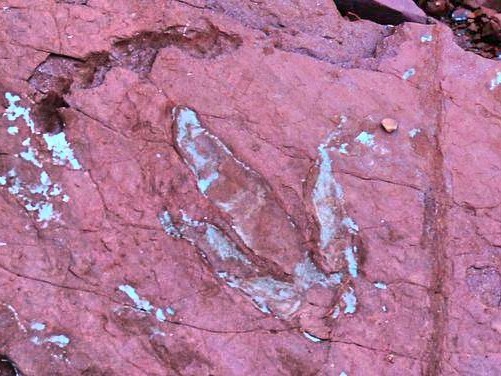
 The tidal power on full display in Nova Scotia’s Bay of Fundy is a major tourist draw, with side-benefits for palaeontologists, too, as was recently demonstrated when tourist Derek Armstrong from Ontario came across some strange three-toed footprints in the rock along the shore at Five Islands Provincial Park.
The tidal power on full display in Nova Scotia’s Bay of Fundy is a major tourist draw, with side-benefits for palaeontologists, too, as was recently demonstrated when tourist Derek Armstrong from Ontario came across some strange three-toed footprints in the rock along the shore at Five Islands Provincial Park.
The strange impressions turned out to be dinosaur footprints.
Promptly snapping some photos, Armstrong, a trained geologist with the Ontario Geological Society, headed down the road to the Fundy Geological Museum, home to some of Canada’s oldest dinosaur fossils, to show his findings to museum director and curator, Tim Fedak and museum staff.
“As soon as I showed them, their eyes opened up,” said Armstrong in conversation with the Halifax Herald. Eventually, experts determined that the fossilized footprints belonged to a lion-sized, meat-eating dinosaur named Anchisauripus who lived approximately 200 million years ago at the dawn of the dinosaur age.
“It’s always cool to see anything relating to dinosaurs or any fossils at all,” says Armstrong. “Footprints are cool because they actually walked there. It’s something tangible left behind. You can imagine them walking across such a beach.”
This week the Fundy Geological Museum is hosting guided tours of the dinosaur fossil site at Wasson Bluff, a 1.6 km stretch of rock cliffs along the Minas Basin which have produced a stunning array of fossils from the boundary era between the Triassic and Jurassic periods, some 200 million years ago.
“It’s so important to have the public contact us when they find something they think might be a fossil,” says Fedak. “Dinosaur footprints like this one provide important information for dating rocks and comparing sites across North America.”
With a range of up to 16 metres, the tides at the Bay of Fundy are some of the highest in the world. The constantly churning waters dig into rock along the coastal cliffs to reveal ancient fossils at sites like Wasson’s Bluff and Joggins, both are treasure troves for dinosaur fans. The fossil cliffs at Joggins, Nova Scotia, a UNESCO world heritage site, have produced the world’s most complete fossil record from the Coal Age or Carboniferous period 300 million years ago.
Last year, a visitor to Joggins came across what scientists believe to be a new (but very old) species of centipede measuring almost a foot in length (not that huge by Coal Age standards, however, as other millipedes from the era have been found at lengths of two metres).
Fundy’s tides are about to serve another purpose, as plans are underway to install two 1,000 tonne tidal power turbines at the Minas Passage near Parrsboro, Nova Scotia.
One of five such green energy initiatives in the works for the Bay of Fundy, the Cape Sharp Tidal project recently ran into opposition in the form of the 175-member Bay of Fundy Inshore Fishermen’s Association, which is seeking a court order to delay the project on grounds that the effects of the huge turbines on the area’s marine ecosystem are not yet fully known.
The group is asking for a one-year delay of the project so that a full scientific baseline of the region’s ecology can be established.
Leave a Reply
You must be logged in to post a comment.



 Share
Share Tweet
Tweet Share
Share




Comment